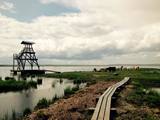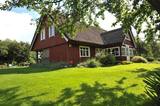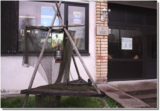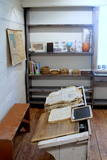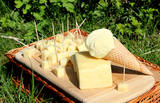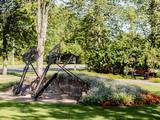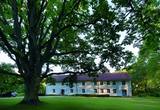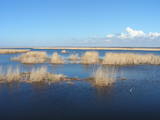| Nr | Name | Beschreibung |
|---|---|---|
|
Engures apkaimē aug 22 no Latvijā sastopamajām 32 orhideju dzimtas sugām .Lai dabas parka apmeklētājiem dotu iespēju aplūkot šīs interesantās augu sugas, ierīkota Orhideju taka. Kopējais takas garums ir 3.5 km, tā sākas netālu no Engures Ornitoloģisko pētījumu centra, līkumo caur kalcifilajiem purviem un mežam putnu novērošanas torņa virzienā, un aizvijas tālāk gar atjaunoto ezera piekrastes pļavu, kurā mīt govis un zirgi. Takas sākumā novietotajā informācijas zīmē attēlotas ne tikai apkārtnē sastopamās orhidejas. Tur iespējams gūt daudzpusīgu informāciju arī par citām interesantām Engures ezera dabas parka augu sugām.
|
||
|
An organic farm where it is possible to read and taste strawberries directly from the field during the season. There are also real wild strawberries. Sea buckthorn is also grown, can be read and tasted in September. Small-scale processing (juices, syrups, frozen products, jams) - home producer status. |
||
|
Wooden slat weaving workshop is located in Jelgava county, Sesava parish. Craftswoman is making different type of wooden slat baskets and basketry from pine, linden, aspen and black alder. There are several different categories of baskets, available in different sizes - picknick baskets, baskets for berry and mushroom picking, trays, baskets for firewood, laundry baskets, onion / garlic baskets, baskets for kids, and diverse baskets for daily use. Various inscriptions and drawings are also made on the weavings. They also accept orders for individual orders. In the workshop it is possible to see the wooden slat basket weaving process as well as have the opportunity to learn to make your own basket. |
||
|
Находятся в 100 м к юго-востоку от Приекульского замка. Символ Приекуле, изображенный на гербе города. Ворота (1688 г., отреставрированы в 1954 г.) служили в качестве сторожевой башни сквозных ворот Приекульской господской усадьбы, где проводился досмотр торговцев (таможня), отправляющихся или приезжающих из Литвы. Интерес представляет родовой герб баронов Корфов выполненный в XVIII веке из голландского песчаника, с серебряным ядром и своеобразный маскарон в центральной части фасада. Во времена баронов в нишах по обеим сторонам стояли двухметровые, выполненные в камне, грозного вида фигуры стражников - солдат. Сегодня на их месте стоят деревянные фигуры стражников. |
||
|
Eine Herde mit ungefähr 200 Ziegen. Der Wirt erzählt mit ein wenig Humor über das Leben mit Ziegen in Lettland und in Europa, über Herstellung des Ziegenkäses und über Geschmacksgeheimnisse, sowie bietet eine Käseverkostung an, nach der man Käse kaufen kann. Die auf diesem Hof hergestellten Käse sind nicht nur gesund, sondern auch sehr köstlich. |
||
|
Eine Burgberg mit einer befestigten Vorburg wurde schon in 10 – 13 Jh. bewohnt. Am Fuße der Burg befand sich eine Stadt. In 1335 – 1347 hat der Livländische Orden auf dem Burgberg eine Steinburg aufgebaut, die im 18. Jh. vernichtet wurde. Ein Aussichtsplatz. |
||
|
Als Treuegabe Herzog Jakob Kettlers an den polnischen König war das Gotteshaus von1640-1642 erbaut worden. In diesem ist unter anderem ein Beichtstuhl mit allegorischen Malereien (1691) erhalten, drei Altäre mit Schnitzereien im Rokoko-Stil und eine Skulptur “Madonna mit dem Kinde” aus dem 16.Jh.. Nach vorheriger Anmeldung kann die Kirche auch von innen besichtigt werden. |
||
|
Der Hof befindet sich auf der Insel Rusnė im Nemunasdelta am Ufer des Mündungsarms Pakalnė. Die Wirtsleute sammeln Kräuter und verarbeiten die nach volkstümlichen Rezepten zu Teemischungen, Aufgüssen und anderen Getränken, die den Gästen angeboten werden, die heilende oder stimmungsaufhellende Wirkung haben und den Tonus heben. |
||
|
Das Denkmal der Gebrüder Kaudzītes steht neben dem Kulturhaus von Vecpiebalga. Die Architektin des Denkmals ist Ausma Skujiņa, die Bildhauerin Marija Eņģele. |
||
|
Museum von Lapmežciems – hier kann
man die Geschichte über den Umkreis,
Schule und Entwicklung des Fischfangs
erfahren. Es gibt auch Material über die
Kämpfe der finnischen Jäger im Umkreis
von Klapkalnciems. Es werden auch
thematische Kurzausstellungen organisiert.
Nebenan steht der Gedenkstein für die
politisch Unterdrückten.
|
||
|
The space is on the second floor of the Jūrkalne library, featuring traditional objects from Jūrkalne and the Suiti people, as well as several looms where locals organise creative workshops. Contact the chamber in advance to arrange for a guide who will tell you all about the culture and traditions of the Suiti and present a film about them. |
||
|
Ein Cafe auf der Sommerterrasse, befindet sich auf dem Strandgelände des Parks von Preili. Das Cafe bietet ein 100% natürliches hausgemachtes Eis mit Beeren an. Vor Ort werden frische Pfankucken "Pampūkas" gebacken. Das Strandcafe ist nur vom Mutterstag (der 8. Mai) bis zum Vatterstag (der 11. September) geöffnet. Für die Touristengruppen – Exkursionen und Verkostung vom Käseeis. |
||
|
Erholungskomplex "Lejasmalas" befindet sich auf dem Ufer des Sees Lejas mit einem schönen Blick auf die Inseln. Lettgallische Gerichte aus den selbs angebauten Produkten. Lettische Küche: Gericht Buļbešnīki (auch mit Karotten), sieben Käsesorten, hausgemachte Würste (gekochte, gebratene, Blutwürste), Gericht Sekonkas (warmes Gericht aus Schweineorganen), Fischsuppe, geräucherte Fische, gefüllte Hechte, Fischfrikadellen, Birkensäfte, Hausbranntwein. Das besondere Gericht: Klöße von Aulejas. |
||
|
Pirts noma, izmitināšana, ēdināšana, banketu zāles noma, internets, makšķerēšana, volejbola laukums. |
||
|
Im bäuerlichen Betrieb am rechten Uferbogen des Flusses Venta werden Ziegen gezüchtet und Käse hergestellt. Der Betrieb empfängt die Besucher und bietet Verkostung und Erwerb von Produkten an. Annahme von Bestellungen. |
||
|
Parkā blakus pusloka tiltiņam ir novietotas trīs milzīgas dzelzs atslēgas, kuras balsta akmens mūris un metāla arkas. Tās simbolizē trīs vēsturiskos centrus un to vienotību – Siguldu, Turaidu, Krimuldu. Dobēs pie šī objekta sezonāli zied dažādi kultūraugi. |
||
|
The central part of the town of Krāslava is an historical monument because its low-story and beautiful wooden buildings. The best views of the historical centre relate to the carp park near the Adamova trail, the Karņicskis hill, the bridge across the Daugava (Prospekta Street), and the Priedaine viewing tower on the left bank of the Daugava River. |
||
|
The first mention of Pēterupe Rectory goes back to the late 17th century. The Manor Park and the buildings have partially survived to the present day, including a linden alley at the end of Smilšu Street, planted by the pastor Jānis Neilands in 1879 and the grand oak planted by Johann Wilhelm Knierim in 1869. After the fire of 1908, the Rectory was restored and partially rebuilt. In Soviet times, the property was removed from the parish and the house was named “Līgotnes”. During German times the Rectory was occupied by legionnaires. After the war, the building of the Rectory was turned into a hospital, then into a secondary school and later it was transformed into a block of flats for teachers. Now the building again belongs to the parish and it is inhabited by a priest of the parish and his family. |
||
|
Der Komplex des Schlosses Švėkšna ist einer der schönsten in ganz Niederlitauen. Neben dem Schloss befindet sich der eindrucksvolle Schlosspark. Beide Teile des Parks werden durch eine breite Freitreppe, von der sich eine wunderbare Sicht auf die Gewässer des Parterres eröffnet, verbunden. Auf der Insel des zentralen Schlossteichs Švėkšna steht noch immer die Skulptur der Göttin Diana. Auf der Hauptallee des Parks wurden die prächtige Sonnenuhr, die Vase auf Podest, die Marienskulptur und der „Freiheitsengel“ wiederhergestellt. Auch andere Elemente des Parks wurden mittlerweile restauriert: der Aussichtspunkt, Wege und Tore. |
||
|
Das ist ein flacher, lagunenartiger See, der mit dem ihn umgebenden Feuchtgebiet von internationaler Bedeutung ist. 271 Vogelarten wurden in diesem Gebiet gezählt, einschließlich 43 Vogelarten, die in der Lettischen Roten Liste aufgeführt sind und 15 aus der Europäischen Roten Liste. Zum Park gehören das Nida-Moor und der Teil des Meeres, das sich längsseits des Parks befindet. Zwischen dem Pape-See und der Ostsee befindet sich Lettlands älteste Vogelberingungsstation, wo nicht nur Vögel beringt werden, sondern auch Fledermäuse. Der Pape-See ist das erste Territorium in Lettland, wo Rückzüchtungen von Wildtieren ausgewildert wurden, um die überschwemmten Wiesen des Sees sachgerecht verwalten zu können. Zuerst waren es Wildpferde (Konik-Pferde), dann Auerochsen und der europäische Bison. Durch den Pape-See führt auch Lettlands einzige markierte Wassertourismusroute. Besucher können Vogel- und Naturbeobachtungstürme nutzen, Naturpfade usw. Das Dorf Ķoņi ist ein einzigartiges Beispiel für ein am Meer gelegenes Fischerdorf. Der Pape-See ist unter den Vogelbeobachtern beliebt. Das Besucherzentrum wurde im “Haus der Natur “ des WWF eingerichtet.
|
||
